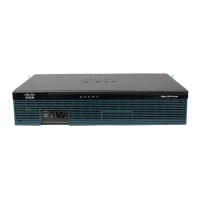53
Cisco 3900 Series, Cisco 2900 Series, and Cisco 1900 Series Integrated Services Routers Generation 2 Software Configuration Guide
Chapter Configuring Ethernet CFM and Y.1731 Performance Monitoring on Layer 3 Interfaces
CFM Support on Routed Port and Port MEP
http://www.cisco.com/en/US/docs/ios/mcl/allreleasemcl/all_book.html provides more information
about these commands.
Caution Because debugging output is assigned high priority in the CPU process, it can diminish the performance
of the router or even render it unusable. For this reason, use debug commands only to troubleshoot
specific problems or during troubleshooting sessions with Cisco technical support staff.
Note Before you run any of the debug commands listed in the following table, ensure that you run the logging
buffered debugging command, and then turn off console debug logging using the no logging console
command.
Table 3 debug Commands for Ethernet CFM Configuration
debug Command Purpose
debug ethernet cfm all Enables all Ethernet CFM debug messages.
debug ethernet cfm diagnostic Enables low-level diagnostic debugging of Ethernet
CFM general events or packet-related events.
debug ethernet cfm error Enables debugging of Ethernet CFM errors.
debug ethernet cfm packets Enables debugging of Ethernet CFM message
packets.
debug ecfmpal all Enables debug messages for all Ethernet CFM
platform events.
debug ecfmpal api Displays debug messages for all Ethernet CFM
platform API events.
debug ecfmpal common Displays debug messages for all Ethernet CFM
platform common events.
debug ecfmpal ecfmpal Enables debugging of all Ethernet CFM platform
events.
debug ecfmpal epl Enables debugging of all Ethernet CFM platform
endpoint list (EPL) events.
debug ecfmpal isr Enables debugging of all Ethernet CFM platform
interrupt service request (ISR) events.

